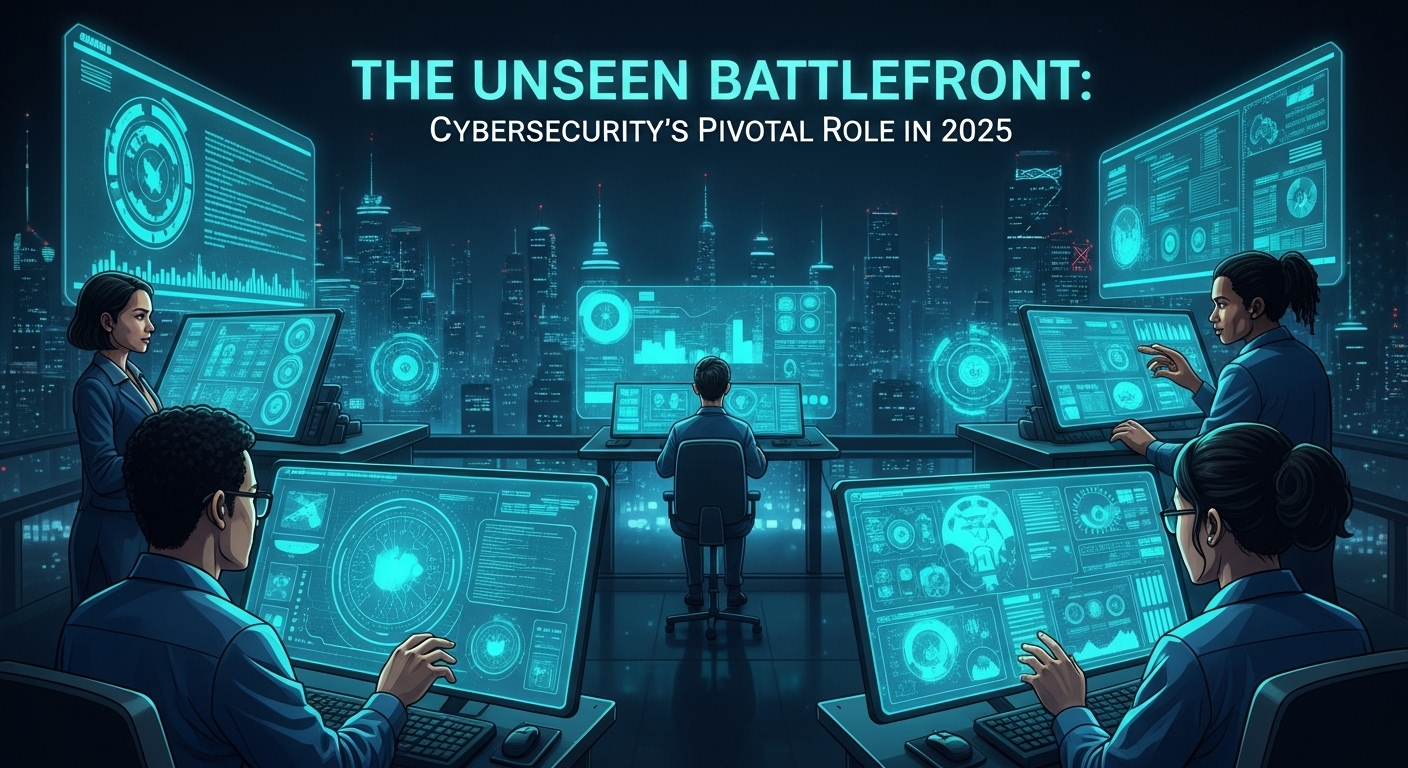In our hyper-connected global society, where nearly every aspect of human endeavor relies on digital infrastructure, “cybersecurity” stands as the invisible shield safeguarding our digitized world. It is the intricate practice of protecting systems, networks, and data from digital attacks, ensuring their confidentiality, integrity, and availability. As of mid-2025, the cybersecurity landscape is more complex, dynamic, and fraught with peril than ever before, demanding continuous adaptation and unprecedented foresight from individuals, corporations, and nation-states alike.
The Evolving Threat Matrix: Adversarial Innovation at Scale
The adversaries in this unseen battle are diverse, encompassing lone malicious actors, sophisticated cybercriminal syndicates operating as highly efficient businesses, and well-resourced state-sponsored groups. These entities are relentlessly innovating, leveraging advanced technologies to launch increasingly sophisticated and scalable attacks:
- AI-Driven Offenses: Artificial Intelligence (AI) is the most significant game-changer on both sides of the cybersecurity arms race. Threat actors are leveraging AI to automate and scale their attacks, creating hyper-personalized and highly convincing phishing emails, generating realistic deepfakes for impersonation and disinformation campaigns, and developing more adaptive, polymorphic malware that can mutate in real-time to bypass traditional, signature-based defenses. The ability of AI to automate reconnaissance and exploit identification dramatically reduces the time from initial compromise to full breach.
- Ransomware’s Persistent Evolution: Ransomware remains one of the most prevalent and damaging forms of cyber-attacks. January 2025 alone saw a record-breaking 92 disclosed ransomware attacks, a 21% increase over the previous year. Sophisticated operations are targeting critical infrastructure, healthcare systems, and financial institutions with unparalleled precision. The rise of “double extortion” (encrypting data and threatening to leak sensitive information) and the continued prevalence of “Ransomware-as-a-Service” (RaaS) models lower the barrier to entry for less skilled criminals, contributing to a surge in costly incidents. Some groups are now even employing data extortion as a standalone strategy, stealing data without deploying ransomware to avoid detection.
- Supply Chain Vulnerabilities Intensify: Organizations’ increasing reliance on third-party vendors, open-source components, and managed service providers (MSPs) has created significant vulnerabilities. Cybercriminals are exploiting weaker links within these extended supply chains to infiltrate larger, more secure targets, leading to widespread breaches and cascading effects across industries. Nearly one-third of all breaches now originate from third-party vendors or partners, with a 40% surge in supply chain-related breaches compared to two years ago. High-profile incidents like the UNFI cyberattack in June 2025 (disrupting a major food supply chain) highlight this fragility.
- Cloud Security Complexity: As businesses globally continue their rapid migration to cloud platforms, securing these dynamic environments presents unique challenges. Misconfigurations, inadequate monitoring, and the exploitation of vulnerabilities in widely used Software-as-a-Service (SaaS) tools are among the top cloud security challenges in 2025. Identity and access management (IAM) oversights, and securing complex hybrid and multi-cloud deployments also remain top concerns for Chief Information Security Officers (CISOs).
- Nation-State Cyber Warfare Escalates: Geopolitical tensions directly fuel sophisticated state-sponsored cyber attacks. These highly resourced adversaries target government agencies, critical infrastructure, defense contractors, and sensitive intellectual property to disrupt operations, steal information, or gain a strategic advantage on the global stage. Recent incidents in 2025 include the compromise of a compliance messaging app used by US government officials (Telemessage breach in May) and the exploitation of critical zero-day vulnerabilities in enterprise software like SAP NetWeaver by state-linked groups.
- IoT Devices as Expanding Attack Surfaces: The proliferation of interconnected Internet of Things (IoT) devices in both homes and businesses creates an ever-expanding attack surface. With over 19.8 billion IoT devices online in 2025, many lack robust built-in security (e.g., default passwords, unpatched firmware), making them vulnerable to exploitation for large-scale Distributed Denial of Service (DDoS) attacks (like variants of the Mirai botnet, still active) or as gateways into broader networks.
- Deepfakes and the Erosion of Trust: The increasing accessibility and sophistication of deepfake technology (AI-generated realistic images, audio, and videos) present unprecedented challenges to trust and authenticity. These are being used for highly effective social engineering, identity theft, financial fraud, and disinformation campaigns, making it harder for individuals and organizations to verify information. Deepfake technology is now sophisticated enough to fool facial recognition and voice authentication systems, making verification through independent channels critical.
The Imperative of Defense: Why Cybersecurity is Non-Negotiable
The importance of robust cybersecurity cannot be overstated. A single cyberattack can have devastating consequences for individuals, businesses, and even national security:
- Massive Financial Losses: The cost of cybercrime worldwide is predicted to reach $10.5 trillion by 2025, a 15% annual increase from 2024 figures. In 2025, the average cost of a single data breach is estimated at $4.88 million for technology companies, and as high as $6.51 million for financial institutions.
- Data Compromise & Identity Theft: Compromise of sensitive personal information, intellectual property, or critical business data can lead to widespread identity theft, severe reputational damage, and loss of competitive advantage.
- Operational Paralysis: Attacks can cripple essential services, shut down businesses, and even impact critical national infrastructure like power grids, transportation systems, and healthcare facilities.
- Erosion of Trust: For organizations, a cyber incident can severely erode customer confidence, leading to a significant loss of market share and long-term brand damage. For society, the rise of deepfakes and disinformation campaigns threatens the very foundations of trust in online information and democratic processes.
Building Resilience: Strategic Cybersecurity Solutions in 2025
Defending against these evolving threats requires a multi-layered, proactive approach involving cutting-edge technology, robust processes, and, crucially, human awareness. Key strategic imperatives for 2025 include:
- AI-Powered Defense: AI and Machine Learning are indispensable tools for defenders. AI-powered systems analyze vast amounts of data in real-time, using predictive analytics to identify potential threats before they materialize. They detect subtle anomalies, flag suspicious activities, and automate responses to low-risk incidents, freeing human analysts to focus on complex threats. The generative AI in the cybersecurity market is expected to grow almost tenfold between 2024 and 2034, indicating its crucial role.
- Zero-Trust Architecture (ZTA) as the Norm: Moving beyond traditional perimeter-based security, Zero-Trust assumes that no entity – internal or external – should be trusted by default. It emphasizes continuous verification, least privilege access, and robust access controls. Gartner predicts that by 2025, at least 70% of new remote access deployments will rely on ZTA rather than VPN services. In 2025, 81% of organizations plan to implement Zero Trust strategies.
- Continuous Threat Exposure Management (CTEM): This emerging approach provides a structured way to measure and reduce an organization’s exposure to threats. It involves proactive identification, prioritization, and mitigation of vulnerabilities and misconfigurations across the entire attack surface. CTEM offers continuous monitoring, risk-based prioritization of remediation efforts, and automated analysis, ensuring defenses evolve alongside emerging threats.
- Strengthening Supply Chain Security: Organizations are implementing rigorous security assessments of third-party suppliers, demanding transparent security practices, and enforcing stringent access controls and continuous monitoring of third-party activities to mitigate cascading risks. Zero-Trust principles are being applied to all third-party access and interconnections.
- Automated Threat Hunting and Incident Response: Automation plays a pivotal role in managing the ever-expanding volume of data and streamlining security processes. Automated threat hunting helps proactively identify and neutralize hidden adversaries, while robust, AI-accelerated incident response plans are crucial for minimizing downtime and damage from successful breaches.
- Human-Centric Security Culture: Despite technological advancements, human error remains a primary attack vector. Comprehensive and engaging security awareness training, continuously updated to address the latest phishing and social engineering tactics (including deepfake recognition), is non-negotiable. Building a robust security culture is a top priority for organizations, requiring a security-first mindset.
- Preparing for Quantum Threats: While fully functional quantum computers capable of breaking current encryption standards are still years away, “harvest now, decrypt later” strategies mean that sensitive data encrypted today could be vulnerable in the future. Organizations are beginning to explore and implement post-quantum cryptography (PQC) to secure long-term sensitive information. In 2025, there will be a surge in announcements of PQC capabilities from vendors, and quantum-safe Hardware Security Modules (HSMs) are becoming standard off-the-shelf products.
- Addressing the Skills Gap: The cybersecurity skills gap continues to be a critical challenge, with millions of unfilled positions globally. This scarcity highlights the urgent need for investment in education, training, and public-private partnerships to build a skilled workforce capable of defending against evolving threats. Top skills in demand include AI/ML in cybersecurity, Zero Trust implementation, IoT/OT security, and threat intelligence.
The cybersecurity landscape in 2025 is defined by complexity, heightened threats, and rapid technological advancements. For individuals and organizations, continuous vigilance, adaptation, and a proactive, integrated approach are not merely options, but absolute necessities. Only by prioritizing robust cybersecurity measures can we truly safeguard our digital future and confidently navigate the complexities of our increasingly interconnected world.

